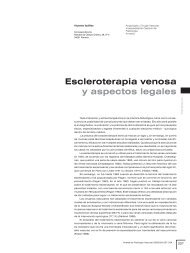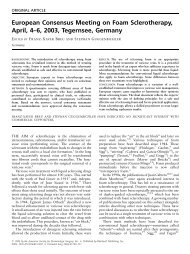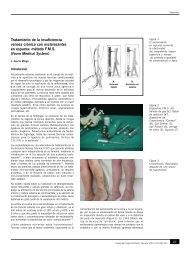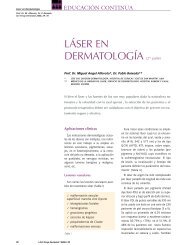The History of Sclerosing Foams
The History of Sclerosing Foams
The History of Sclerosing Foams
You also want an ePaper? Increase the reach of your titles
YUMPU automatically turns print PDFs into web optimized ePapers that Google loves.
696 WOLLMANN: THE HISTORY OF SCLEROSING FOAMS Dermatol Surg 30:5:May 2004<br />
proportion is 0.524j40.74. In the polyhedral foam,<br />
in contrast, the amount <strong>of</strong> liquid between the bubbles<br />
is so small that the individual bubbles get closer and<br />
closer to each other, thus forming polyhedrons. <strong>The</strong><br />
gas proportion j is greater than 0.74. In a foaming<br />
fluid (e.g., beer), all types generally occur, the<br />
polyhedral foam being above the spherical foam and<br />
the gas dispersion and liquid below.] Once the needle<br />
is in the vein, the bubbles can be made to course along<br />
the minute veins and can be followed visually in their<br />
transit.’’ Nowadays, ethanolamine oleate is no longer<br />
available in most countries. <strong>The</strong> ‘‘agitation technique’’<br />
was refined in the following years and is no longer in<br />
use. <strong>The</strong> air:sclerosant ratio <strong>of</strong> 1 plus 1 described by<br />
Foote suggests that the dispersion was very fluid so<br />
that it could not be used for displacing the blood in<br />
larger diameter veins.<br />
1949—Karl Sigg: 8 Foam-Block Technique and<br />
Viscosity <strong>of</strong> Foam<br />
In 1949, Karl Sigg picked up the air-block technique<br />
described 5 years before: Also for other varices than<br />
spider veins, i.e., larger veins, he used the new<br />
technique and reported more than 4000 treatments<br />
performed ‘‘without problems.’’ Sigg describes the<br />
rationale for the use <strong>of</strong> the air-block technique in a<br />
similar manner as Orbach and Foote: ‘‘<strong>The</strong> purpose is<br />
to prevent the dilution <strong>of</strong> the solutions for injection in<br />
the vein by the blood and to ensure that the sclerosant<br />
gets in contact with the intima <strong>of</strong> the vein in a rather<br />
concentrated formy. Even with this small-scale use,<br />
the air bubble chased the blood before the injection<br />
fluid arrived and thus cleared the way for a closer<br />
contact <strong>of</strong> the sclerosant with the venous intima.’’<br />
Later, Sigg combined Orbach’s air-block technique<br />
and Foote’s foam application and thus introduced a<br />
new aspect into the therapeutic options known to that<br />
date: ‘‘Orbach’s method becomes even more beneficial<br />
if foam is injected instead <strong>of</strong> airy. This foam is less<br />
rapidly washed away in the varicose vein than it<br />
happens with the pure injection <strong>of</strong> air.’’ Thus Sigg<br />
introduced for the first time the idea (even if not<br />
pronounced) <strong>of</strong> increased viscosity <strong>of</strong> foam. With the<br />
use <strong>of</strong> foam, he improved the air-block technique<br />
(introducing a foam block), but without omitting the<br />
fluid sclerosant (see Figure 4). Sigg described his own<br />
procedure for the manufacture <strong>of</strong> foam; the glass<br />
syringe filled with fluid sclerosant was held with the<br />
opening pointing downward. Approximately 1 mL <strong>of</strong><br />
air was aspirated through it, pearls developed in the<br />
solution, and thus more or less large bubbles were<br />
generated in the syringe.<br />
Figure 4. <strong>The</strong> foam-block technique: First, foam was injected to<br />
maintain the displacing effect <strong>of</strong> the air block for a longer time (top),<br />
and then normal liquid sclerosant was injected (bottom).<br />
1950—Egmont James Orbach: 9,10 Vasospasm<br />
after Foam Sclerotherapy<br />
A later publication by Orbach reveals the first attempt<br />
to compare the efficacy <strong>of</strong> foam (administered as air<br />
block and foam) with the efficacy <strong>of</strong> fluid sclerosants.<br />
<strong>The</strong> end point was the length <strong>of</strong> the sclerothrombus<br />
generated by the injection <strong>of</strong> the respective substance.<br />
<strong>The</strong> efficacy <strong>of</strong> the foam generated by agitation <strong>of</strong> the<br />
syringe or drug vial was increased approximately 3.5to<br />
4-fold compared with the same amount <strong>of</strong> ‘‘conventional’’<br />
fluid. <strong>The</strong> observation <strong>of</strong> a ‘‘marked<br />
vasospasm’’ after injection <strong>of</strong> foam is nowadays<br />
considered to be an important immediate end point<br />
for the assessment <strong>of</strong> the efficacy <strong>of</strong> modern sclerotherapy.<br />
11–13 This (reversible) vasospasm, which is<br />
<strong>of</strong>ten clearly detectable in duplex-guided sclerotherapy,<br />
can be considered to be a sign <strong>of</strong> initial vascular<br />
damage after sclerotherapy. After administration <strong>of</strong> a<br />
viscous foam, vasospasm is more common and more<br />
pronounced than after sclerotherapy with conventional<br />
fluid. 42 An important factor in this respect is<br />
that a given volume <strong>of</strong> a blood-displacing foam can<br />
spread over a much longer venous segment after a<br />
vasospasm occurs and can even act at a certain<br />
distance from the site <strong>of</strong> administration. (For example,<br />
1 mL <strong>of</strong> a viscous foam completely fills a vein <strong>of</strong> 8 mm<br />
in diameter over a length <strong>of</strong> approximately 20 mm. A<br />
reduction <strong>of</strong> the vessel diameter owing to spasm to<br />
2 mm distributes the same foam volume to a length <strong>of</strong><br />
almost 32 cm. In vivo, a spasm <strong>of</strong> a mean length <strong>of</strong><br />
28 cm could be provoked with vessels <strong>of</strong> 4 to 8 mm in<br />
diameter and a foam application <strong>of</strong> 2 to 2.5 mL <strong>of</strong><br />
double-syringe-system foam.) As long as vasospasm<br />
exists, venipuncture at the same site is aggravated. <strong>The</strong><br />
use <strong>of</strong> small venous cannulae or catheters may help<br />
dealing with this.<br />
Because foams in current use are very different from<br />
those used by Orbach, it is impossible to draw<br />
conclusions about the general efficacy <strong>of</strong> foam from<br />
this experiment. Nevertheless, according to all findings<br />
and based on theoretical considerations, the efficacy <strong>of</strong><br />
foam is always higher than that <strong>of</strong> the same amount<br />
and concentration <strong>of</strong> fluid. <strong>The</strong> level <strong>of</strong> increased<br />
efficacy cannot be predicted in the individual case<br />
without sufficient standardization. <strong>The</strong> increased






